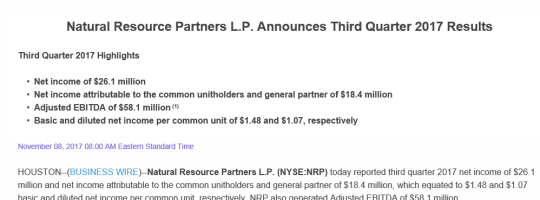Earnings Press Releases are the customary way for public companies to report highlights from a recently ended quarter to the press and public before they file their formal SEC filing.

Not every company issues an earnings release, and the style and information contained by the press release will vary from company to company.
In general earnings press releases take two forms: Preliminary and Standard, with some companies using both, and others just one or the other.
A preliminary earnings release usually contains a small set of ‘preliminary’ (subject to change) financial results, like revenue and cash flow, often times heavily rounded or presented in ranges. This is to give investors a quick overview of the quarter just ended even while the final numbers are still being double checked.

A standard earnings
release on the other hand will normally contain ‘final’ numbers presented
in greater detail. The majority of companies include at least a full income
statement. Many will contain a balance
sheet and even cash flow statement as well.

In addition to being released in advance of the company’s formal annual or quarterly report, earnings press releases also contain some important information that may not be found in the formal 10-K or 10-Q at all:
1) Non-GAAP financial metrics:
These ‘adjusted’ metrics are the companies’
attempt to tell their story on their own terms. These metrics are derived from ‘official’
GAAP numbers, but include adjustments in order to help analysts better understand
the company’s results.

This often involves removing ‘non-recurring’ items like restructuring costs, or non-cash items like share based compensation.
The running joke of course is that these adjustments almost always end up making the company look far better off than the GAAP numbers would suggest. For this reason regulators have been taking pains recently to make more rules about what is and is not appropriate. However, you should always use them with at least some skepticism.
All non-GAAP financial metrics must include a reconciling table to show how they were calculated. This will usually appear near the bottom of the release.
There are other rules about NON-GAAP metrics here: https://www.sec.gov/divisions/corpfin/guidance/nongaapinterp.htm
2) Guidance/Outlook:
Many companies provide future predictions about
their expected performance. They will choose a few metrics and give an
approximation of what they expect for the coming quarter and/or coming year.

Looking at the company’s past actual performance as compared to its past guidance estimates can give you an idea how well you can trust their current predictions. Some companies have a history of under promising, which means they try to ‘guide low’ and then ‘beat’ each quarter. Other companies try to hit their guidance exactly.
Guidance will sometimes be updated as the period goes on and new information is available. Companies are required to make public to everyone any new information they give to anyone about their financial standing and predictions, and generally must also file a copy of this information with the SEC in the form of an 8-K.
3) Non-GAAP Industry Specific Operating Metrics:
For example, Monthly Active Users, Backlog/Bookings, Comparable Store Sales, Customer ‘Churn’, and others.

These are additional metrics that add more detail about the company’s performance.
These items may seem straightforward, but always
remember there are no strict definitions that apply across all companies. So,
one company’s churn calculation may differ from another’s, for example, making
them incomparable. If you are using these metrics to compare one company to
another, make sure you check the definitions.
Next Up…How to use Calcbench to Research Earnings Releases.
Also,
Click here to download our full Earnings Release Analysis Guide.